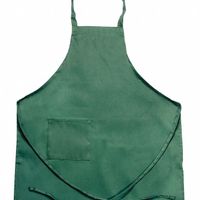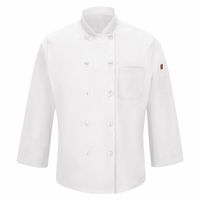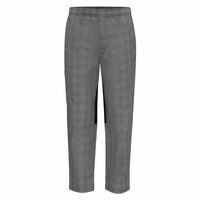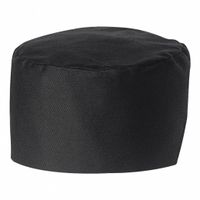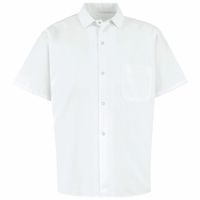Call +(254) 703 030 000 / 751 483 999 / 721 704 777
- Home
- Furnishings Appliances Hospitality
- Tableware Smallwares Food Service Storage Transport
- Food Service Apparel
Frequently Asked Questions
What is the purpose of foodservice apparel?
The purpose of foodservice apparel is multifaceted, serving both practical and regulatory functions within the food industry. Primarily, it ensures hygiene and safety, which are critical in preventing food contamination. Apparel such as aprons, gloves, hairnets, and chef hats are designed to minimize the risk of foodborne illnesses by preventing hair, skin particles, and other contaminants from coming into contact with food.
Additionally, foodservice apparel provides protection for workers. It shields them from potential hazards such as hot liquids, sharp objects, and other kitchen dangers. For instance, heat-resistant gloves and aprons protect against burns, while slip-resistant shoes help prevent falls in often wet or greasy kitchen environments.
Uniformity and professionalism are also key purposes of foodservice apparel. Uniforms create a cohesive look that can enhance the brand image of a restaurant or foodservice establishment. They help in identifying staff members, which is particularly important in large operations or during busy service times. This professional appearance can instill confidence in customers regarding the cleanliness and quality of the establishment.
Moreover, foodservice apparel can contribute to employee comfort and efficiency. Well-designed uniforms made from breathable, durable materials can improve comfort during long shifts, thereby enhancing productivity. Customizable features, such as adjustable aprons or jackets with ample pocket space, can further aid in the efficiency of foodservice operations.
Finally, compliance with health and safety regulations is a critical aspect of foodservice apparel. Many regions have specific guidelines regarding what must be worn in food preparation areas to ensure safety and hygiene standards are met. Adhering to these regulations is essential for legal compliance and maintaining the establishment's reputation.
How do aprons protect kitchen staff?
Aprons serve as a crucial protective barrier for kitchen staff, safeguarding them from various hazards encountered in a culinary environment. Firstly, aprons protect against spills and splashes. In a bustling kitchen, hot liquids, oils, and sauces are frequently in use, and an apron can prevent these substances from coming into direct contact with the skin, reducing the risk of burns and scalds.
Secondly, aprons help maintain hygiene standards. They act as a shield against food particles, bacteria, and other contaminants that might be present on clothing, ensuring that these do not transfer to the food being prepared. This is particularly important in preventing cross-contamination, which can lead to foodborne illnesses.
Additionally, aprons protect clothing from stains and damage. Kitchen work often involves handling ingredients that can permanently stain or damage regular clothing, such as tomato sauce, wine, or grease. By wearing an apron, kitchen staff can keep their uniforms or personal clothing clean and intact, which is essential for maintaining a professional appearance.
Aprons also provide a layer of protection against sharp objects. In a kitchen, knives and other cutting tools are in constant use, and an apron can offer some degree of protection against accidental cuts or punctures.
Moreover, aprons with pockets offer practical benefits, allowing kitchen staff to keep essential tools and utensils within easy reach, thereby improving efficiency and workflow.
In summary, aprons are an essential part of kitchen attire, offering protection from physical hazards, maintaining hygiene, preserving clothing, and enhancing operational efficiency.
What are the benefits of wearing chef coats?
Chef coats offer several benefits, including:
1. **Protection**: Chef coats are made from thick, durable materials that protect against spills, splashes, and burns from hot liquids or oils. The long sleeves and double-breasted design provide an additional layer of safety.
2. **Hygiene**: The coats are designed to maintain high hygiene standards. They are easy to clean and often made from materials that resist stains and odors, ensuring that chefs maintain a professional appearance.
3. **Professionalism**: Wearing a chef coat signifies professionalism and expertise. It is a symbol of the culinary profession and helps establish authority and respect in the kitchen.
4. **Comfort**: Chef coats are designed for comfort during long hours in the kitchen. They are typically made from breathable fabrics that allow for air circulation, helping to keep chefs cool.
5. **Functionality**: Many chef coats come with practical features such as pockets for holding thermometers, pens, or small tools, making them functional for everyday kitchen tasks.
6. **Uniformity**: Chef coats contribute to a uniform appearance among kitchen staff, promoting a sense of team unity and cohesion. This uniformity can also enhance the dining experience for customers by presenting a clean and organized kitchen environment.
7. **Durability**: The materials used in chef coats are chosen for their durability, allowing them to withstand the rigors of a busy kitchen environment and frequent washing.
8. **Versatility**: Chef coats are available in various styles and colors, allowing chefs to express their personal style while maintaining a professional look.
Overall, chef coats are an essential part of a chef's attire, offering protection, comfort, and a professional appearance.
Why are chef pants important in the kitchen?
Chef pants are crucial in the kitchen for several reasons. Firstly, they provide comfort and flexibility, essential for chefs who spend long hours on their feet and need to move quickly and efficiently. The loose fit and breathable fabric help in maintaining comfort throughout the day.
Secondly, chef pants are designed for safety. They are typically made from durable materials that offer some protection against spills, splashes, and minor burns. The fabric is often heat-resistant, which is vital in a kitchen environment where hot surfaces and open flames are common.
Hygiene is another important factor. Chef pants are easy to clean and often come in dark colors or patterns that can conceal stains, maintaining a professional appearance. This is crucial in a setting where cleanliness is paramount.
Functionality is also a key aspect. Chef pants usually have multiple pockets, allowing chefs to carry essential tools and utensils, keeping them within easy reach. This enhances efficiency and productivity in a fast-paced kitchen environment.
Additionally, chef pants contribute to a professional appearance. They are part of the traditional chef uniform, which helps in maintaining a standard of professionalism and can also boost team morale and unity.
Lastly, chef pants are often designed to be unisex and come in a range of sizes, making them accessible and suitable for all kitchen staff, promoting inclusivity and equality in the workplace.
How do kitchen shirts differ from regular shirts?
Kitchen shirts, often referred to as chef jackets or chef coats, differ from regular shirts in several key ways:
1. **Material**: Kitchen shirts are typically made from thicker, more durable fabrics like cotton or polyester blends to withstand the heat and rigorous conditions of a kitchen. Regular shirts are often made from lighter materials like cotton, linen, or synthetic blends.
2. **Design**: Kitchen shirts usually have a double-breasted design, allowing chefs to reverse the front if one side gets stained. This feature is absent in regular shirts, which typically have a single-breasted design.
3. **Functionality**: Kitchen shirts often include features like thermometer pockets, pen pockets, and sometimes even a small loop for a towel. Regular shirts generally lack these functional elements.
4. **Closure**: Chef jackets often use cloth knot buttons or snaps, which are heat-resistant and easy to remove in case of emergencies. Regular shirts typically use plastic or metal buttons.
5. **Fit and Comfort**: Kitchen shirts are designed for ease of movement and comfort during long hours of work, often with a looser fit. Regular shirts may have a more tailored fit, focusing on style rather than functionality.
6. **Color and Style**: While regular shirts come in a wide variety of colors and patterns, kitchen shirts are usually white or black to maintain a professional appearance and to easily identify stains for cleaning.
7. **Heat Resistance**: The fabric of kitchen shirts is often treated to be more heat-resistant, providing an extra layer of protection against burns. Regular shirts do not typically have this feature.
8. **Durability**: Kitchen shirts are designed to withstand frequent washing and the harsh conditions of a kitchen environment, whereas regular shirts may not be as durable.
What types of headwear are used in kitchens?
In kitchens, headwear is essential for maintaining hygiene and safety. The most common types include:
1. **Chef Hats (Toques):** Traditional tall, pleated hats worn by chefs. They signify rank and expertise, with the number of pleats sometimes representing the number of techniques a chef has mastered. They help keep hair out of food and absorb sweat.
2. **Skull Caps:** Close-fitting caps that cover the hair completely. They are practical, comfortable, and often used in fast-paced kitchen environments. They are easy to wash and maintain.
3. **Bandanas:** Versatile and easy to wear, bandanas are tied around the head to keep hair in place. They are popular for their casual look and are often used in less formal kitchen settings.
4. **Hairnets:** Lightweight nets that cover the entire head, ensuring no hair falls into food. They are mandatory in many food production environments for strict hygiene control.
5. **Baseball Caps:** Often used in casual or fast-food kitchens, these caps are comfortable and help keep hair back. They can also be branded with the restaurant's logo for a uniform look.
6. **Berets:** Sometimes used in European kitchens, berets offer a stylish alternative while still serving the purpose of keeping hair contained.
7. **Visors:** These are less common but can be used in kitchens where visibility and ventilation are priorities. They keep hair back while allowing the head to stay cool.
8. **Disposable Caps:** Made from lightweight materials, these are used in environments where hygiene is critical, and frequent changes are necessary.
Each type of headwear serves the dual purpose of maintaining hygiene by preventing hair from contaminating food and ensuring safety by keeping hair away from flames and equipment.
How does foodservice apparel contribute to kitchen safety?
Foodservice apparel plays a crucial role in enhancing kitchen safety by providing protection, maintaining hygiene, and ensuring compliance with safety standards.
Firstly, protective clothing such as chef coats, aprons, and pants are designed to shield kitchen staff from burns, spills, and splashes. These garments are often made from flame-resistant materials that minimize the risk of burns from hot liquids, oils, or open flames. Long sleeves and high collars offer additional protection for the arms and neck.
Secondly, non-slip shoes are essential in preventing slips and falls, which are common accidents in kitchens due to wet or greasy floors. These shoes are designed with slip-resistant soles that provide better grip and stability, reducing the likelihood of injuries.
Thirdly, headwear like hats or hairnets is vital for maintaining hygiene and preventing hair from contaminating food. This not only ensures food safety but also complies with health regulations. Hairnets and hats also help in keeping sweat away from the face, which can be a distraction and a safety hazard.
Additionally, gloves are used to protect hands from cuts, burns, and contamination. Cut-resistant gloves are particularly important when handling sharp tools, while heat-resistant gloves are necessary for handling hot pots and pans.
Finally, foodservice apparel often includes color-coded uniforms or aprons to distinguish between different roles in the kitchen, which helps in maintaining an organized and efficient workflow. This organization reduces confusion and potential accidents.
Overall, foodservice apparel is integral to creating a safe and efficient kitchen environment by providing necessary protection, ensuring hygiene, and supporting compliance with safety standards.
